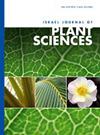体细胞胚胎发生介导的芒果Vellaikolunban和Olour多胚品种珠心组织微繁殖
IF 0.9
4区 生物学
Q4 PLANT SCIENCES
引用次数: 0
摘要
2016年至2019年,班加罗尔ICAR印度园艺研究所在多胚芒果中尝试了由珠心组织介导的体细胞胚胎发生微繁殖。对体细胞胚胎发生的不同阶段进行了优化研究,即体细胞胚胎的诱导、增殖、转化、成熟、发芽和利用珠心组织体外建立植株。对于培养起始,利用了品种Vellaikolunban和Olour授粉后不到20天到授粉后60多天的不同果实发育阶段。Vellaikolunban授粉后30–40天和Olour授粉后40–50天的果实产生了更好的愈伤组织百分比,愈伤组织萌生和愈伤组织形成的天数更少。胚胎愈伤组织在含有鲁吉尼橄榄(RO)成分、6%蔗糖和5 2,4-二氯苯氧基乙酸(2,4-D)和赤霉素(GA3)各ppm。在转移到增殖培养基(RO含6%蔗糖,5 在4-5周内形成亲球状和球状胚胎。体细胞胚胎在心脏早期、心脏晚期和子叶阶段的进一步发育发生在转化培养基中(半浓度B5盐、全RO有机物、5 ppm的吲哚-3-乙酸(IAA)、20%的椰子水和200mgL-1的酪蛋白水解物)。通过使用0.01 mg L-1脱落酸(ABA)和100 mg L-1的聚乙二醇(PEG)。在5 ppm的玉米素。我们的研究结果表明,体细胞胚胎发生可以作为传统繁殖方法的替代方法,在多胚芒果品种中快速繁殖均匀的种植材料。本文章由计算机程序翻译,如有差异,请以英文原文为准。
Somatic embryogenesis mediated micropropagation of polyembryonic cultivars of mango Vellaikolumban and Olour using nucellus tissue
Somatic embryogenesis mediated micropropagation from nucellus tissue was attempted in polyembryonic mango at the ICAR-Indian Institute of Horticultural Research, Bengaluru during 2016–2019. Studies were conducted to optimize the different stages of somatic embryogenesis namely induction, proliferation, conversion, maturation, germination of somatic embryos and ex vitro establishment of plantlets using nucellus tissue. For culture initiation, various developmental stages of fruits ranging from less than 20 days post-pollination to more than 60 days-post pollination of cultivars Vellaikolumban and Olour were utilized. Fruits of 30–40 days post-pollination in Vellaikolumban and 40–50 days post-pollination in Olour gave better percentage callusing with fewer days for callus initiation and callus formation. Embryonic calli developed on induction medium containing Rugini olive (RO) constituents, 6% sucrose, and 5 ppm each of 2, 4-Dichlorophenoxyacetic acid (2, 4-D) and Giberellic acid (GA3). Upon shifting to proliferation medium (RO with 6% sucrose, 5 ppm each of 2, 4-D and GA3, 400 mgL-1of glutamine and 20% v/v coconut water) pro-globular and globular embryos were formed within 4–5 weeks. Further development of somatic embryos through early heart, late heart and cotyledonary stages occurred in conversion medium (half strength B5 salts, full RO organics, 5 ppm of Indole-3-Acetic Acid (IAA), 20% coconut water and 200 mgL-1 of casein hydrolysate). Maturation of embryos was obtained by using 0.01 mg L-1of Abscisic acid (ABA) and 100 mg L-1of Polyethylene glycol (PEG). Germination of embryos with shoot and root initiation was observed in the presence of 5 ppm of zeatin. Our results show that somatic embryogenesis can be used as an alternative method to conventional propagation methods for rapid multiplication of uniform planting material in polyembryonic mango cultivars.
求助全文
通过发布文献求助,成功后即可免费获取论文全文。
去求助
来源期刊

Israel Journal of Plant Sciences
生物-植物科学
CiteScore
1.90
自引率
0.00%
发文量
17
审稿时长
>12 weeks
期刊介绍:
The Israel Journal of Plant Sciences is an international journal of extensive scope that publishes special issues dealing with all aspects of plant sciences, including but not limited to: physiology, cell biology, development, botany, genetic
 求助内容:
求助内容: 应助结果提醒方式:
应助结果提醒方式:


